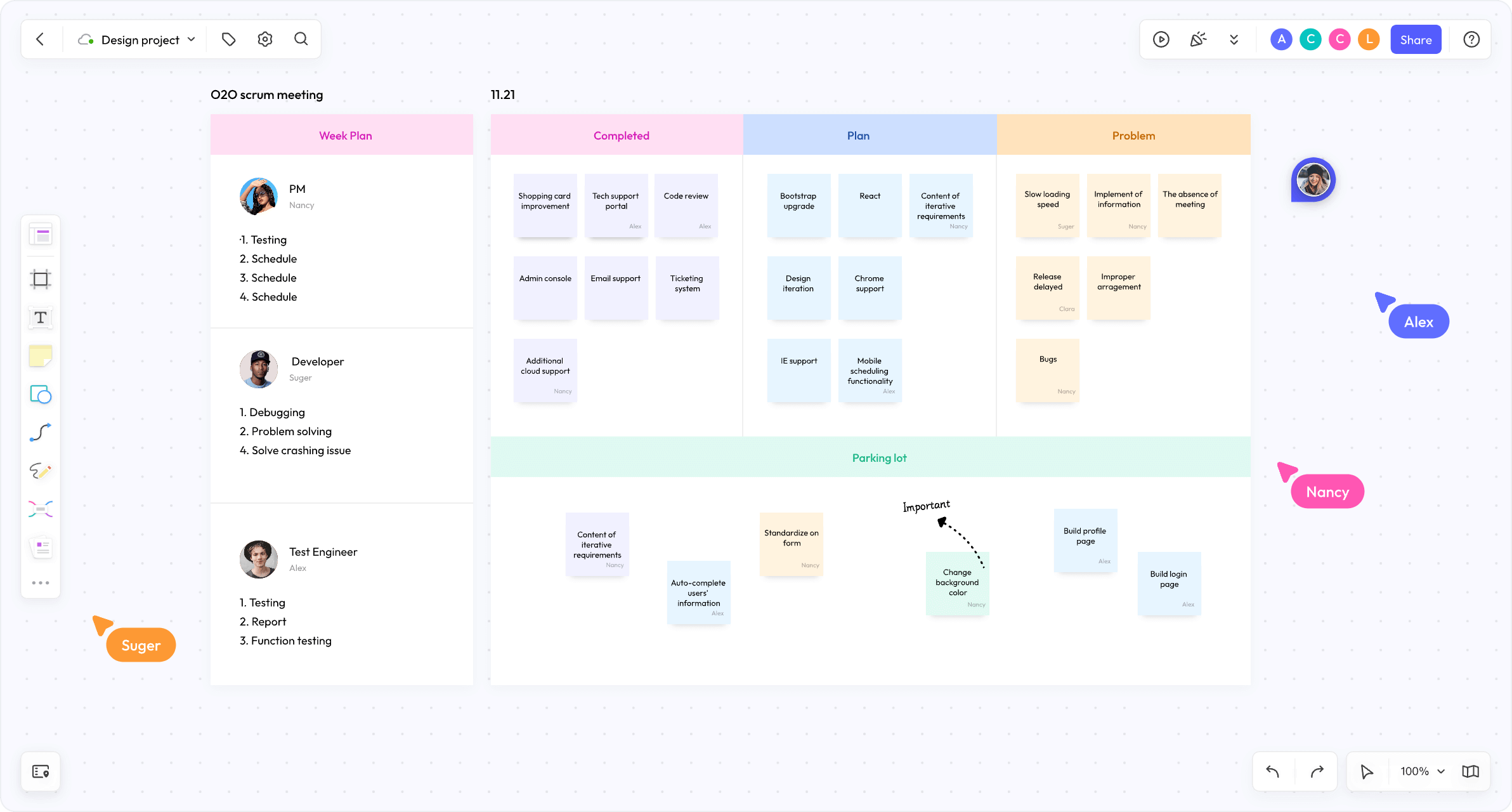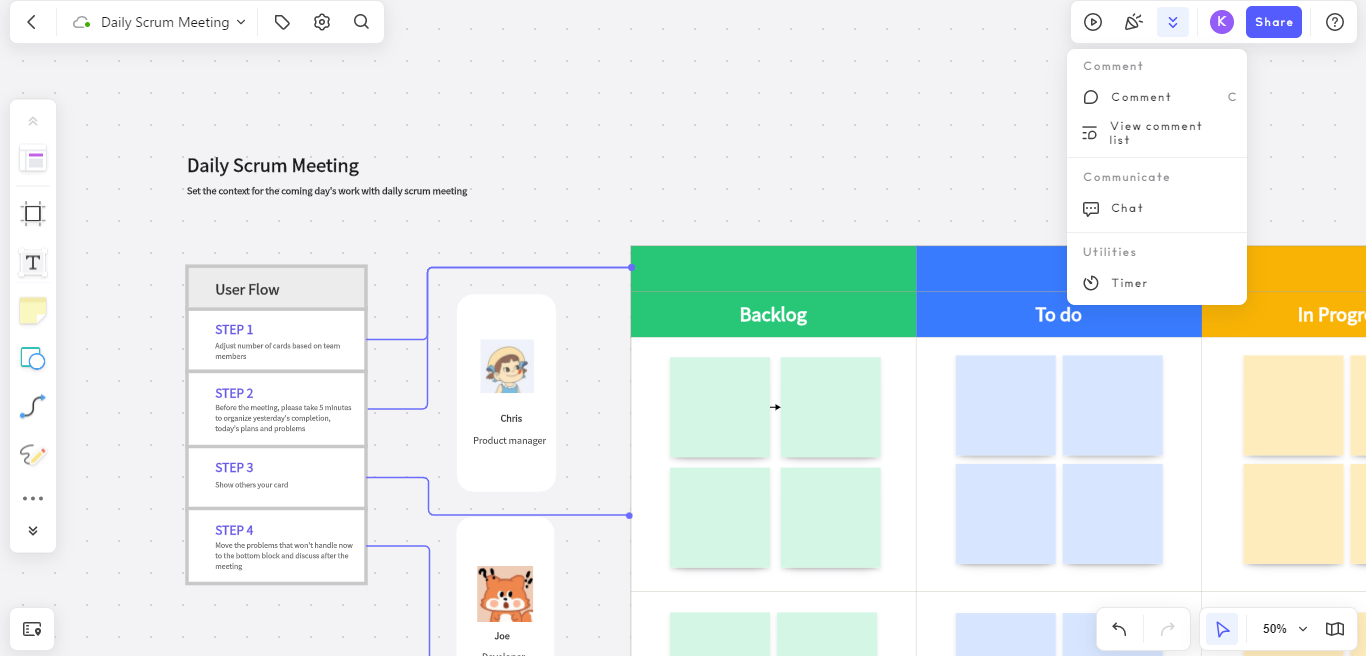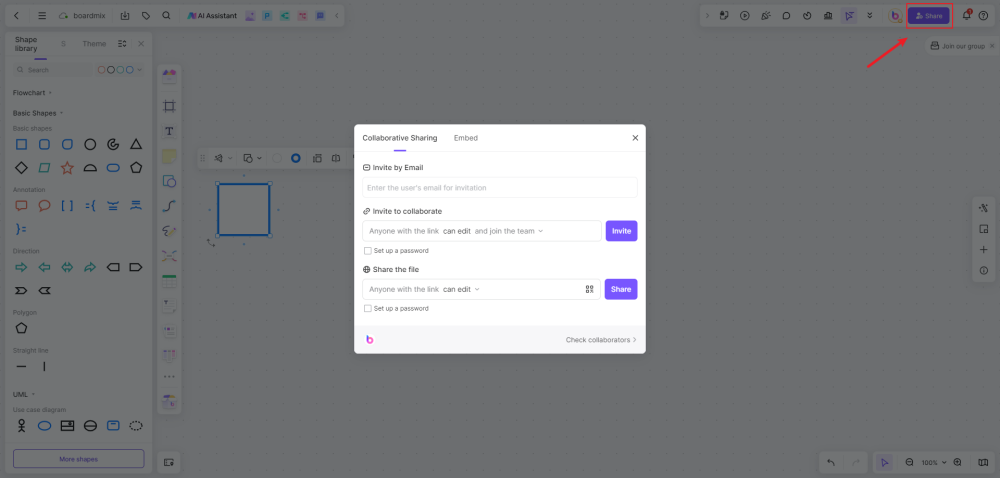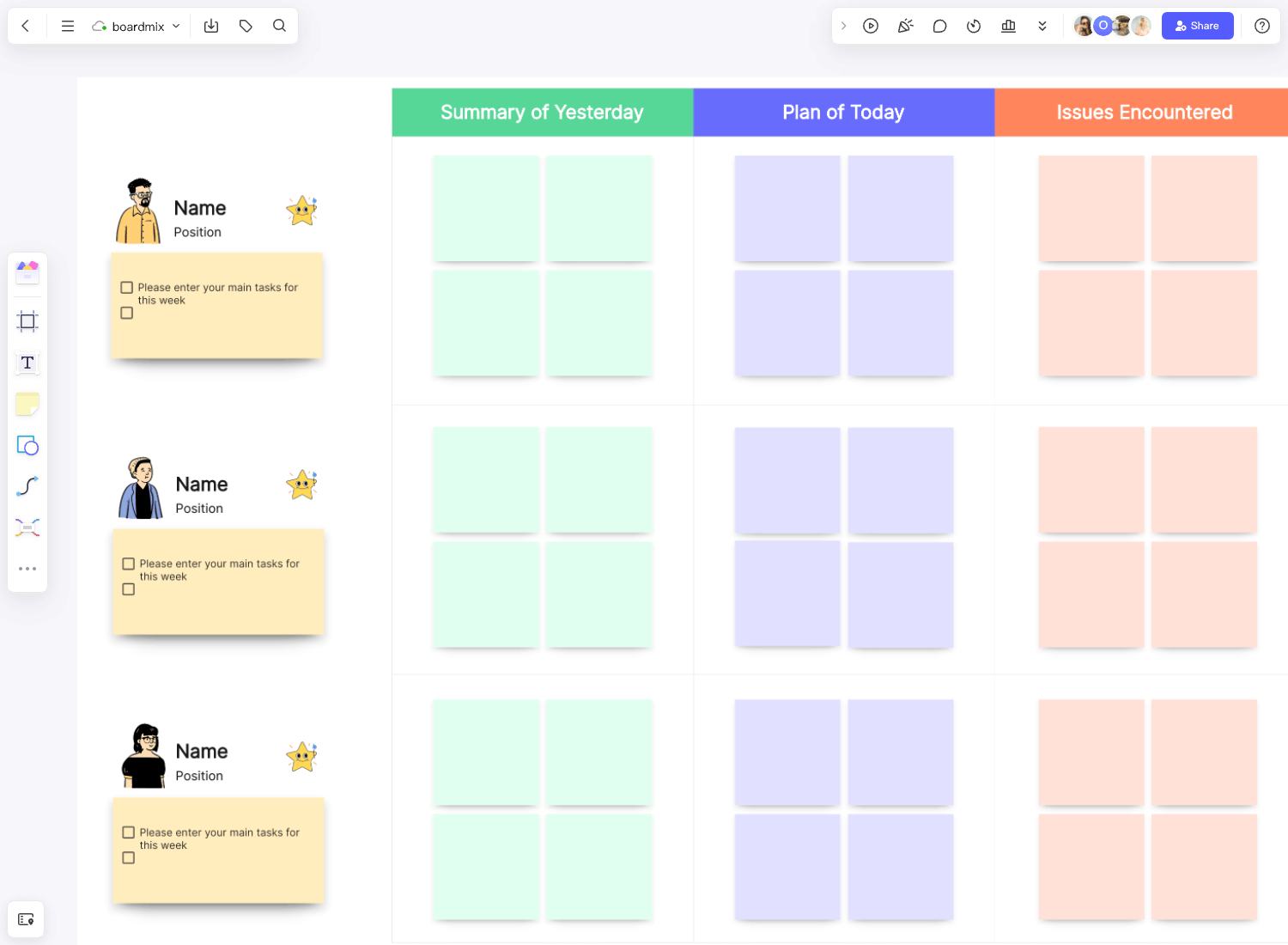Time is often at a premium in a busy work environment so things are done as quickly as possible. Companies simply don't have the luxury of having a daily sit-down breakfast meeting for updates, which would take an hour or more. Hence, the daily scrum meeting has become a valuable part of the workday.
What is a daily scrum meeting?

The daily scrum meeting, also known as the daily stand-up meeting, is a vital collaborative session where department employees or project team members come together at the beginning of the day to get everyone up to speed on the project's progress and goals. It commences with a comprehensive recap of the previous day's accomplishments, allowing everyone to celebrate achievements and build momentum for the day ahead. Next, a thorough run-through of the actionable plans for the current day ensures everyone is aligned and aware of their responsibilities.
Lastly, the meeting shifts focus to identifying and addressing potential challenges and roadblocks, fostering a proactive approach to problem-solving, and ensuring the work progresses smoothly and efficiently. This structured and inclusive daily practice fosters effective communication, boosts team cohesion, and ultimately leads to successful project outcomes.
Although it is called a stand-up meeting, no rule says everyone needs to be standing up during the meeting. Still, that is just what frequently happens, with everyone preferring to stand until the discussion is finished. The daily scrum meeting ideally takes 15 minutes or less. To keep your meetings within this strict time constraint, it is highly recommended that you use a daily scrum meeting template to serve as your guide.
Why are daily scrum meetings necessary in your company?
So much more than just a ritual that companies have become used to, the daily scrum meeting has multiple purposes. The primary objective of these meetings is to keep everyone on the same page and to promote better collaboration toward the achievement of the collective goal.
Check the progress toward the goal
It is crucial to know the progress as this will show whether the project is on track, or whether you need to speed up to make the target. The daily reports from all members will ensure that everyone knows exactly what progress has been made.
Boost efficiency and collaboration
The daily scrum meeting reveals which areas of a project are particularly challenging and require more support. With this information, you can reallocate resources or manpower accordingly to maintain balance and keep moving forward. Also, constant feedback keeps a healthy level of collaborative effort toward the success of the undertaking.
Promote self-organization
Having a daily standup encourages all members to manage and organize their work properly, and stay accountable for whatever role they have been given. It eliminates the need for a specific person to track progress and manage workflow and lets the project manager focus on the more crucial tasks at hand.
Practical tips to hold an effective daily scrum meeting
There are no hard rules on how to conduct an effective daily scrum meeting, but there are general guidelines that most teams follow, as well as some tried and tested tips that would help you get the most out of your daily standup.
Conduct the meeting at the same time and place every day
This kind of consistency helps in establishing the meeting as an integral part of each work day. Oftentimes, it is done in the morning before work commences and while everyone is fresh and minds are at their sharpest. Some prefer to do it as a culminating activity at the end of the day, which also makes sense.
Regardless of your chosen schedule and venue, you must follow a daily scrum meeting template to maintain consistency and keep the meeting as brief as possible.
Cover all relevant topics but keep discussions concise
Remember that it should take no longer than 15 minutes to do a daily standup. In giving their reports or feedback, everyone should just stick to the gist and refrain from starting unnecessary discussions. Of course, this doesn’t mean that ideas that are out of topic must be shut down. If someone comes up with something brilliant, make a note of it set a separate meeting to discuss it, and stick to following the daily scrum meeting template in the meantime.
All team members must answer the 3 questions
A daily scrum meeting will work best if all relevant participants are present and actively involved. This means everyone must answer the three questions – what they have accomplished the previous day, what their tasks are for today, and what challenges or difficulties they have faced.
Recognize good progress
When a team member accomplishes a small goal or reaches a milestone, the team should show them appreciation with applause or a pat on the back. This is a great way to keep everyone motivated.
The Application of Daily Scrum Meetings in Different Industries
In this guide, we present detailed templates for daily scrum meetings tailored to three different industries: Healthcare, Marketing, and Education. Each template includes structured segments on plans, problems, and coordination, ensuring that all essential aspects of the daily stand-up are addressed. By utilizing these templates, teams can enhance their communication, streamline their workflows, and effectively tackle any challenges that arise in their respective fields.
Healthcare Daily Scrum Meeting
In healthcare, daily scrums bring together medical professionals, including doctors, nurses, and administrative staff, to discuss patient care, coordinate tasks, and resolve any logistical issues. These meetings ensure that patient care is streamlined and efficient. And as an important work meeting, that can enhance coordination among healthcare providers, leading to better patient outcomes and helps in managing resources effectively, such as staffing and medical supplies.
Marketing Daily Scrum Meeting
Daily stand-ups in marketing help teams stay on top of campaign progress, share creative ideas, and address any barriers to successful project execution. These meetings ensure that marketing strategies are executed smoothly and aligned with business goals. Meanwhile, keeps all team members aligned with marketing goals and strategies, and allows for real-time tracking of campaign performance and quick adjustments.
Education Daily Scrum Meeting
Daily scrums in education bring together teachers, administrators, and support staff to discuss lesson plans, student progress, and any administrative issues. These meetings ensure that educational activities are well-coordinated and focused on student outcomes. Additionally, ensures that teaching activities are consistent and aligned with curriculum goals and provides a platform for educators to share best practices and continuous improvement.
How to use the daily scrum meeting template
The daily scrum meeting template is an indispensable tool for keeping daily standups agile. Before you utilize the template for your meetings, customize it to include all team members, assign unique colors per member, and rearrange it to represent your team structure effectively. Once the meeting starts, each gains access to the daily scrum meeting template, which contains three sections they must fill out.
This tailored approach ensures seamless collaboration and enhances team engagement during the daily stand-up, facilitating a productive and goal-oriented work environment. Each section corresponds to each of the three scrum questions. The members will then take turns sharing their answers to the question until everyone has had their turn.
The daily scrum meeting template provides a significant amount of order and consistency to the daily standup, but it is up to the participants to give quality input that would make these meetings a success.
How to Create Your Daily Scrum Meeting Using Boardmix
Boardmix scrum task board is simple, easy to use, and highly flexible. The following guide will help you set up a scrum task board without hurdles.
Step 1: Log in to Your Boardmix Account
To begin, you'll need to access your Boardmix account. Go to the Boardmix website and enter your login credentials. If you don't have an account yet, you can sign up for a new one for free.

Step 2: Search and Choose the Daily Scrum Meeting Template
Once you're logged in, head over to the Template library. You can find this in the main dashboard. Please search for the daily scrum meeting Template and click to use it for free.

Step 3: Customize and Edit Your Daily Scrum Meeting
Now that you've chosen the template, it's time to customize it according to your needs. You can decorate your template with shapes, lines, drawing pens, icons, and other tools. The daily scrum meeting Template comes with several sections that you can fill out.
-Create your user flow chart that explains how the scrum task board will be used.
-Press and hold the Ctrl key along with the + or – key to zoom in or zoom out on any section of the board.
-The task board cards are arranged in columns and blocks, use text tools to label the columns and write on the cards. There are tools listed on the left side, which are used to make different changes on the taskboard.

Step 4: Save Your Work, Share and Collaborate
When customizing your daily scrum meeting Template, Boardmix autosaves your progress, but it's good practice to manually save before exiting.
Next, share your daily scrum meeting to collaborate with your team. Click on the "Share" button on the top right corner of the screen, copy the sharing link, and send it to anyone whom you want to collaborate with. People can join this file to edit and collaborate on this file in real-time by clicking this sharing link. We encourage your team to leave comments, suggest edits, or ask questions online so you can adjust it in time.

FAQs about the daily scrum meeting
What is the daily scrum meeting format?
It is a 15-minute meeting designed for providing updates, planning what to do for the day, and making adjustments to overcome roadblocks.
What are the 3 questions asked during a daily scrum meeting?
The format of the questions varies depending on the daily scrum meeting template that you are using but basically, they ask what has been done, what is to be done for the day, and what problems have been encountered.
How do I prepare for a daily scrum meeting?
Before the meeting starts, you must already have an answer to each of the three questions because there is no time for delays. Some groups allow members to answer the questions in the daily scrum meeting template so that when the meeting begins, they can go directly to share the answers.







